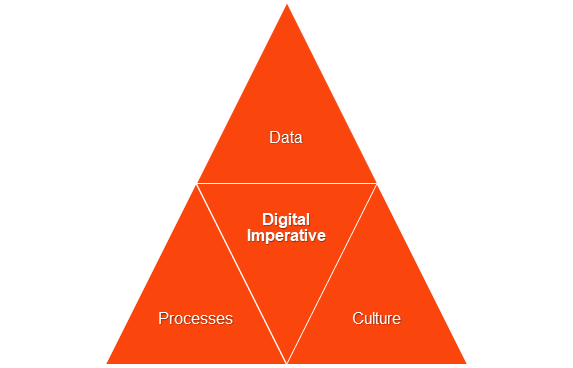
You might have already heard of the ‘digital imperative’ – the phrase has grown increasingly popular over the past few months. With our most forward-thinking clients, we’ve seen this replace ‘digital transformation’ as their area of focus. But what does the digital imperative really mean in terms of business application services?
As well as presenting together at our Digital Revolution³ virtual event, our Dynamics Product Director Duncan Kerr, Head of Business Applications Kathryn Hutchinson and Sales Manager Melanie Best share their thoughts here on how business applications can bring value to your organisation.
Staying ahead of change with business application services
We have said it many times over the years, but the pace of change is accelerating. When we think we have reached maximum speed, it increases yet again. This means that to stay successful and competitive, organisations must stay agile, be able to innovate, and find the time to process all the data, signals and information to make the best decision they can in an appropriate timeframe.
Operationally, this means that systems must be integrated, manual processes must be removed, access to applications must be ubiquitous and data must be gathered and analysed on a timely basis.
Strategically, leaders must have access to the relevant information – this being data processed to inform them – so they can make timely decisions and receive quick feedback on those decisions to understand whether they are working or not.
The digital imperative drives organisations to transform their processes using business applications so that they can do all the above. Otherwise, the risk is that competition and disruption within their markets, as well as external geopolitical and economic factors, will see them be overtaken.
How can business applications help?
The question underpinning the digital imperative is how to achieve this. Firstly, you need to be honest about where you are on the digital transformation journey. We can ask a few questions to figure this out:
- Have you identified inefficient processes – do you understand where your data is, what format it is in, and how it ties together?
- Are you still having periods of disruption while applications are ‘upgraded to the latest version’, potentially with no real business benefit other than to stay current? This can be a significant distraction, not just to the IT department, but also to users who have to test the upgrade.
- Do users have easy access to the applications they need to do their jobs as efficiently as possible?
- Finally, is the overarching culture of your organisation one of transformation or of simply doing what you have always done because it worked?
Embarking on this sort of review is challenging – but it can be simplified. It is worth focusing on three key areas: data, processes and culture:

Business applications and your data
Organisations should understand what data they have, where it is, and how up to date it is. If you’re using new technology such as artificial intelligence (AI) and machine learning, cleaning every element of data is no longer necessary. Old habits die hard, but the need to categorise every element manually and focusing on minimising duplication is time consuming – and again, it doesn’t add tangible benefit.
However, data can be processed by business applications with the application of sentiment analysis and approximation to automatically present rich, cohesive information. For instance, Microsoft Dynamics 365 Customer Insights will allow organisations to take their customer data from sources across the business, for example Excel, Outlook, customer relationship management (CRM), enterprise resource planning (ERP), web and eCommerce.
You can then build rules for your business applications to link, de-duplicate and enhance your data with other sources, as well as apply AI models to enhance it. Then you can build clear measures, such as propensity to churn or best-spending customers, and provide that to relevant business users to drive action, whether that is segmented marketing campaigns, account-based marketing and selling, or customer service and retention.
How well do your business users across the organisation know your customers? It’s imperative they know them better than the competition.
Enterprise apps for business processes
Do you listen to your employees? When it comes to their applications and processes, what do they complain about? Do they simply accept the manual, laborious re-entry and manipulation of data, or are they able to innovate so they can focus on the important tasks, the value-added work that will drive the company’s objectives forward? This does not mean that organisations need to change their business applications wholesale, nor all at once. Nothing transforms overnight – it must be an incremental process.
You can start by identifying processes that are taking up the most time, are most inefficient or frustrating, and then reimagine how they could be achieved. Integration between systems is much easier now than it was previously thanks to connections such as Web Services and technology such as IPaaS (Integration Platform as a Service).
Are there simple manual data-gathering processes such as filling in Word or Excel templates, or even physically on paper? These can be replaced quickly and efficiently using the Power Platform: you can build a Canvas Power App to capture the data with all the relevant validation and business rules needed to improve data quality.
When the data is captured, does something need to happen, especially if there are exceptions? If so, then Power Automate can be used to trigger workflows to notify users or update another system. To put it in context, there are more than 800 connections to other apps.
Now you have the data, who needs to see it and how? You can bring all the data into one place, enrich it with data from other systems, and provide reports and dashboards through Power BI.
It’s possible that you have moved along the digital transformation journey. Perhaps during COVID-19, you replaced your on-premises finance system with a cloud-based platform such as Dynamics 365 Business Central. Have you explored what it can do? For example, did you know that it is:
- hosted by Microsoft, meaning there is no maintenance of technology;
- evergreen with no upgrade projects;
- continuously updated so you can leverage the latest features;
- ubiquitous, requiring only browser and internet connection to access from anywhere.
These apps can do so much more that your old system – incorporating workflow, bringing down the cost of (formerly) enterprise-level functionality such as OCR and automation of purchase invoices, and integrations with systems.
Make sure you review what you are doing and push to transform your processes using these applications. Make a list of actions then pick off the low-hanging fruit.
Assessing your organisation’s culture towards business apps
The final element of the digital imperative is culture. Organisations are nothing without the people they employ.
Those that have existed for many years will have a more instilled culture, but it is imperative that the whole organisation looks to transform. Not just the IT department or the board, but all employees.
There is a depth of capability in each organisation; we see great ideas coming from all levels. But without a culture that encourages these ideas to surface, the organisation will fall behind.
As part of the digital transformation, organisations can introduce apps that help capture innovation (indeed one of the demonstration model-driven Power Apps does just that) and can feed back on great ideas. Communication and the wider change management is vital. Even smaller organisations are seeing the need for support on this as they realise they need to focus on doing what they do well.
Leveraging our business application services
While there are many ways to approach the challenge of the digital imperative, ultimately it is most important to just get started. In today’s world, it is that much harder to know where the end goal is, so instead, identify the most valuable areas to address and begin the process. Start small and iterate to keep achieving outcomes.
Get in touch with us if you want to find out how we can support your business applications or assess where you are in your digital transformation journey – and, in the current climate, how you can do more with less.
Sign up for more insights from our Digital Revolution³ on-demand virtual event
Our experts examine in detail just what the digital imperative means for you, for us, and the workforce.



